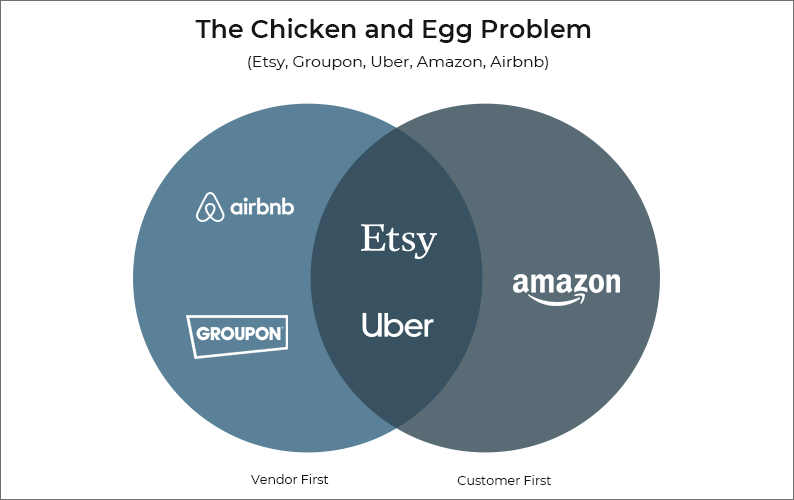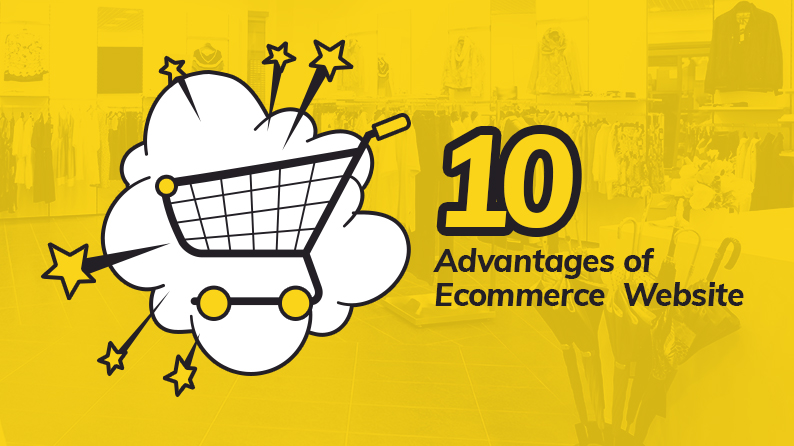Business Strategies To Address The Online Marketplace Chicken and Egg Paradox
A multi-vendor marketplace has both sellers and buyers. An operative multi-vendor marketplace has a self-sustainable virtue, the buyers and sellers both provide and derive value from each other, stimulating mutual growth.
But when most two-sided marketplaces are launched in the market, they are faced with the fabled question, Which came first, the chicken or the egg?
The chicken and egg problem in online marketplaces is strategizing between onboarding vendors first or attracting customers.
So, before the two-sided marketplace is up and running, you would need to formulate business strategies to answer this question. Read ahead to understand what strategies can be beneficial for your multi-vendor marketplace and how leading brands have implemented those strategies in their quest to solve chicken and egg problem.
What is the Chicken-Egg Problem in Online Marketplaces?
Chicken and egg paradox is simply interconnected events that depend on each other to form a cyclic process. The conundrum presents a perplexing choice between the events.
A two-sided marketplace needs both vendors and buyers. But the existence of both is interdependent. The vendors “exist” in a multi-vendor marketplace to sell their products or services to the customer and the customer sign up to the marketplace to buy the products or services that the vendors sell.
If the marketplace has just begun its operations and none of the two are present, it will be dilemmatic to identify a starting point between onboarding vendors first or attracting customers.

Nevertheless, taking into account the resources available, you would have to formulate a marketing strategy. Your approach may entail prioritizing one over the other.
The same conundrum is faced by many multi-vendor marketplaces. However, successful marketplaces have led the way forward by addressing this chicken and egg problem through innovative marketing strategies. Discussed here under are some such examples.
Case Studies – How Amazon, Uber, Etsy, Airbnb or other Successful Marketplaces Solved Chicken and Egg Problem
Etsy
Etsy is a vertical marketplace that caters to a niche market segment. It enables vendors to sell handicrafts and other related products on the marketplace.
Did Etsy face the chicken-egg paradox when it first started out?
The answer is no. Etsy had a sound business strategy working for them that made the initial phase of the marketplace easier to navigate through.
Although, before Etsy, eBay was a well-established platform where personally crafted handicrafts could be sold too. But eBay is a horizontal marketplace. The vendors that sell handicrafts wanted functionalities in the marketplace that was specific to the product that they were selling.
The founders of Etsy identified that there is a scope of a marketplace that focuses on selling only handicrafts and similar items. In other words, they identified the right vendor profile, which benefited from a marketplace.
Moreover, Etsy is a peer-2-peer marketplace, so vendor onboarding and customer acquisition are simultaneous.
Thus, with the well thought out approach, Etsy could evade the chicken and egg paradox. Read this extensive online guide to build handicraft items marketplace like Etsy.
Groupon
Groupon leads the way as far as lean startups go. It started as a WordPress blog!
Let’s see how Groupon strategized to avoid the chicken-egg paradox?
When the founders of Groupon started the marketplace, they had to decide between onboarding vendors and attracting customers.
They identified the need for increasing the cash flow in business as the pain point that would help them in convincing business owners or vendors to onboard the marketplace.
And once they have the vendors onboard, they would be able to attract the customers.
They listed deals on their website featuring businesses that had signed up with them.
The businesses had to pay nothing to feature in the ads. They paid only when a business transaction was completed.
They liked the idea and signed up with Groupon.
This is how they countered the chicken-egg problem in the marketplace by attracting vendors first.
Uber
In Uber’s case, the taxi business had existed much before they started to provide services. So what approach did they take to find answers to the chicken-egg conundrum? How did they convince the taxi owners or the customers to use their services?
Strategy Adopted by Uber to Solve the Chicken and Egg problem
The answer lies in an approach that identified the right vendor profile, added value to their business, and at the same time, having a strategy to attract customers simultaneously by timing the launch of their services when demand was more than the supply
Uber identified black-cab service providers, who were already doing business, and leveraged the use of technology to attract them. They offered the taxi drivers a mobile and an app that they could use to provide services in their free time, adding to their existing income.
Moreover, Uber has always launched their service in a new city during the holiday season or whenever the demand for taxi service is maximum. This ensured that the vendors had maximum chances of getting customers owing to the increased gap between demand and supply.
This is how Uber solved the chicken and egg problem in the marketplace by having a well thought out strategy.
Amazon
One can’t talk about anything in eCommerce until one mentions Amazon! The company had reached the second spot in Fortune 500 in the year 2020. It continues to inspire startups across the globe.
So, how did Amazon find its way to solve the chicken and egg problem?
When Amazon started its operations as an online marketplace, the company had been doing e-business prior to it for some time.
The company had started as a book retailer. This had helped the company generate a customer base.
So, when Amazon started as a multi-vendor marketplace, it used the same customer base from the earlier business. In other words, Amazon simply enhanced its business from a single vendor to a multi-vendor marketplace.
By following this strategy, Amazon could attract customers before starting out as an eCommerce marketplace, thus finding answers to the chicken and egg paradox.
Airbnb
According to stratosjets.com, there are 2.9 million hosts on Airbnb worldwide in 2021. But at the start, Airbnb had no hosts or customers on the website. The company had a unique business model. There were similar websites, but none that were exactly the same as Airbnb.
So how did Airbnb, with a unique concept, solve the chicken and egg problem?
The answer lies in a well-researched and innovative strategy to address the chicken and egg problem.
Through research, Airbnb could understand that the landlords that might use their service were on Craigslist. In other words, their target vendors were on Craigslist.
They prepared a list and sent emails to the landlords on that list. Within a short time, they were able to onboard landlords who listed on their website.
More importantly, Airbnb just took the details of the landlords from Craigslist. But unlike them, Airbnb employed a free service wherein the landlords were able to upload professionally clicked photos of their properties.
This is the service that helped them to onboard vendors, without having any customers in the marketplace.
Thus Airbnb understood the target audience, the competition and formulated their business strategy accordingly. Moreover, the company added value to the vendors by offering the professionally clicked photos service.
This is how Airbnb were able to address the chicken and egg problem.

Summarizing The Business Strategies Of Established Marketplaces
The approach of these popular markets elucidates the following information on how to address the chicken-egg paradox.
For startups and SMEs that have a limited brand value to leverage, will find it difficult to convince customers to sign up on the ecommerce marketplace. Just like the popular multi-vendor marketplaces discussed in the above examples, onboarding vendors has been a more popular and viable approach adopted by marketplaces to find an answer to the chicken and egg problem.
But even in attracting vendors, the popular multi-vendor marketplaces have led the way forward by adopting well researched, unique, and measured business strategies by analyzing the market, target audience, and existing competition.
Let’s further analyze these business strategies that popular multi-vendor marketplaces have adopted in onboarding vendors in the section that follows.
What are the Best Strategies For Onboarding Vendors First To An Online Marketplace?
As an eCommerce startup, one may not have a brand image yet, but what one does have is a novel business idea that can be pitched to potential vendors.
Based on the examples of popular marketplaces shared in this write-up, enlisted below are business strategies that a startup or a SME can adopt to onboard vendors.
- Targeting the right vendor profile
Most of these companies targeted the right vendor profile. They identified the vendors who benefited significantly from a platform that brings their business online.
By leveraging the features and functionalities of their marketplace, these e-companies presented an opportunity to these vendors to enhance their business via their marketplace platform.
So, in providing the right answers to the right people, these companies successfully onboarded the vendors
- Focus on a niche market
The competition has been steadily increasing in the eCommerce sector. The more the business owners can narrow down the category of products that are sold in a multi-vendor marketplace, the easier it gets for the business to pitch the marketplace in front of the vendors.
Like Etsy, your online marketplace will be identified with a specific category of products.
With a potentially better-defined customer base, onboarding vendors to the marketplace will be easier.
Additionally, this will also make it easier for the business to market the marketplace, as the target audience will be more defined.
- Provide more value to the vendors via the marketplace
To attract the vendors to the marketplace, one has to look to add value to their business. The value can be enhanced ease of doing business, increased earning opportunities, providing a platform that would promise a customer base for their products or many other such benefits.
Etsy created a platform that tried to address all major pain points faced by vendors selling handicrafts. In spite of an established platform like eBay, vendors still registered with Etsy.
As in the case of Uber, even if the vendors (or service providers) didn’t realize the need for an online platform, it created an ecosystem via its marketplace that would give the vendors’ business a boost.
The added value for the vendors can also be in the form of additional service. This service can be beneficial to the vendors even before they start to shop from the marketplace.
Airbnb’s professional portfolio is an example of such a service. The landlords benefitted from a professionally clicked portfolio of their properties, even before they had customers on Airbnb itself.
- Understand the customer needs
To formulate an appropriate business strategy for onboarding vendors. it is important to understand what the customer expects from the marketplace. Once that can be done, it will be possible to launch a marketplace that the vendors would love to sell on.
Uber and Airbnb understood the needs of customers that made them come up with a marketplace that the vendors readily onboarded.
- Market the business with the right message
An important part of the vendor onboarding process is to establish the brand image of the marketplace. The marketing campaign should send out a message of trust and reliability of the marketplace.
An effective marketing campaign will help to get the message across to the vendors, helping with the process of onboarding vendors to your marketplace.
- Leveraging technological benefits of the marketplace
The multi-vendor marketplace can provide a better platform than the existing ones by offering better features and functionalities to both the vendors and the customers.
Airbnb, with their free professionally created portfolio service for the landlords, managed to attract landlords who had listed on Craigslist. Their properties looked much better in the professionally created portfolios from Airbnb. This enhanced their chances of getting customers. Therefore, they started to turn to Airbnb to get listed.
The multi-vendor eCommerce software on which the marketplace is built must have the features that can help in onboarding vendors. Read ahead to find out how the technological benefits of the right multi-vendor software can assist in attracting vendors to the marketplace.
Multi-vendor eCommerce Software Features That Aid In Vendor Onboarding
A multi-vendor eCommerce software is the medium between the business owner and the vendors. One can leverage the features of the marketplace to attract vendors to it.
Target the right vendor profile at the start of the marketplace with these marketplace software features:
- Scalability
Scalability will let a new marketplace have a humble start with the option to scale up when the business grows. This means that initially, the marketplace owner can be very selective in targeting the right vendors. As the business grows, one can broaden the vendor’s description that is to be targeted.
- Support for multiple revenue models
As the owner of the marketplace, one can have the flexibility to earn via subscriptions or commissions, or both. This will help to formulate a revenue model that is best suited to the marketplace. An appropriate revenue model will help to onboard vendors in the marketplace.
- Personalized Vendor Store fronts
A multi-vendor eCommerce software that allows vendors to have their own personalized store front will add value to their store and their brand
- Mobile first approach

Mobiles are fast becoming the first choice device to shop on eCommerce sites for the majority of buyers. Vendors also want their products to be available on marketplaces with mobile applications. You should consider an eCommerce software that is responsive for all screens and has mobile applications for both Android and iOS platforms.
- Pre-integrated APIs to assist in shipping, tax management and other essential business functions
- Product Catalog management to add and manage details of the products on sale
- Multiple Payment Methods for the buyers to add to the convenience of shopping in the marketplace.
To Sum It Up
One can draw inspiration from the case studies of established multi-vendor ecommerce marketplaces. Judging by how the established marketplaces have countered the chicken and egg problem, it may be safe to assume for online marketplaces that are startups, onboarding vendors first is more prudent and feasible.
The reason why this would work is that to attract customers first, the business owner would need to have a brand image or an in-house product that would make the customers sign up before the vendors.
The vendors will, however, look beyond the brand image if the marketplace presents a unique value proposition and adds value to their business.
By doing careful analysis of the market and using creativity in the approach, the multi-vendor marketplace owner can formulate a business strategy that is best suited to the marketplace.
Make sure to opt for the right multi-vendor software that enables and assists to implement the business plan and helps to solve the chicken and egg paradox.
The business plan of the marketplace should have a plan for both onboarding vendors and attracting customers, it is just a question of whom to approach first.
Explore the features of Yo!Kart That will help you in onboarding vendors
————
Disclaimer: Yo!Kart has no relation with the above-mentioned online businesses or marketplaces. The related information and statistics are purely driven from the data available on the internet.




